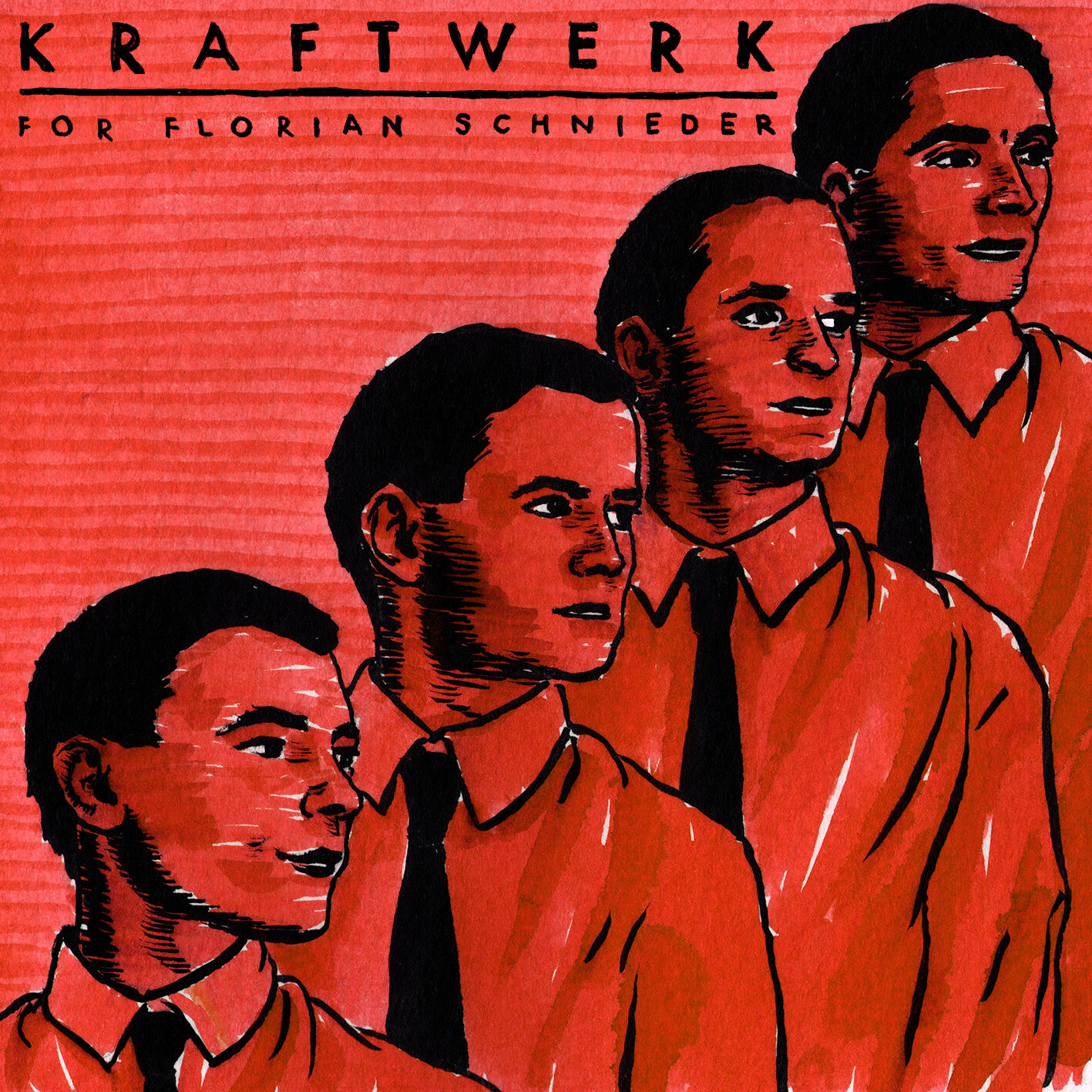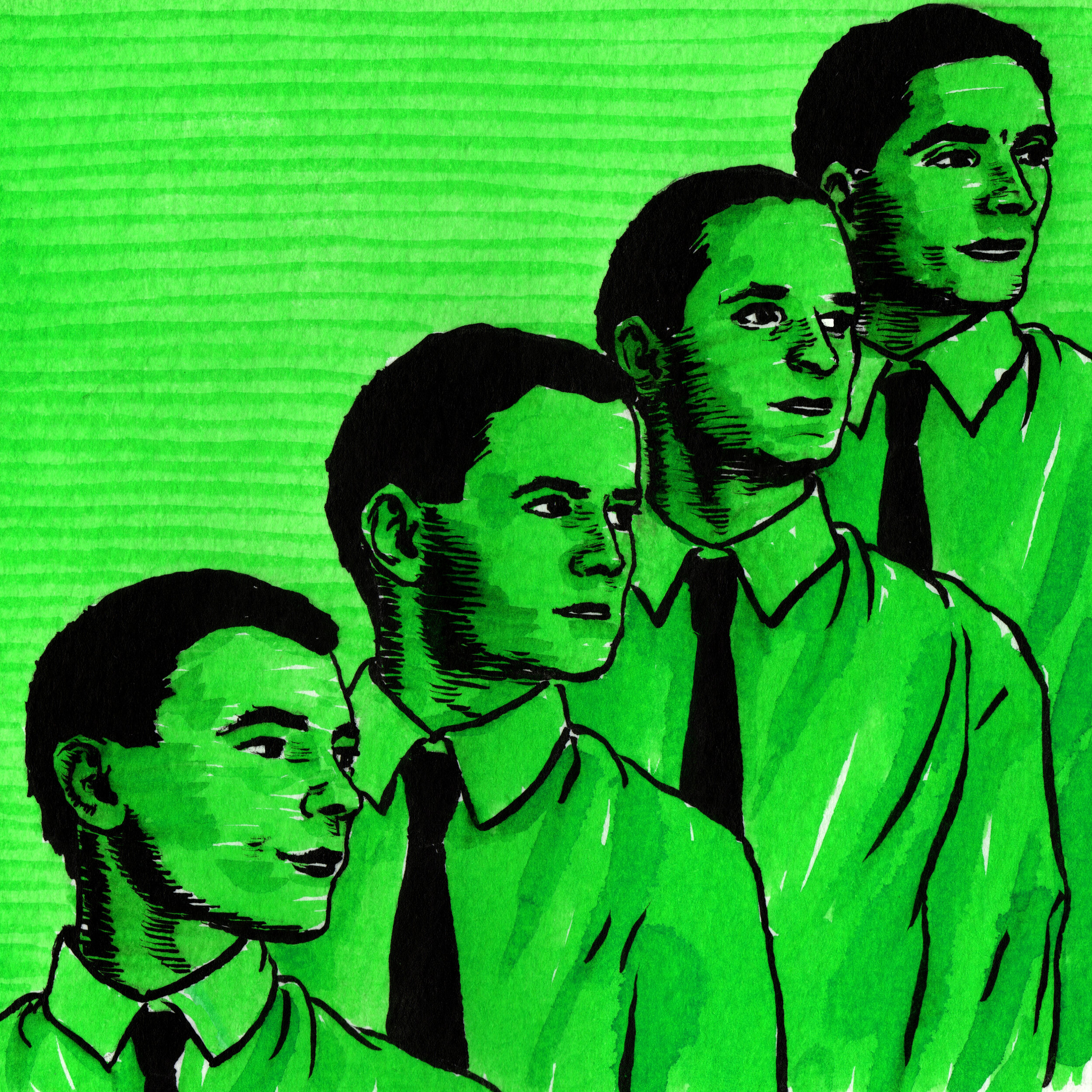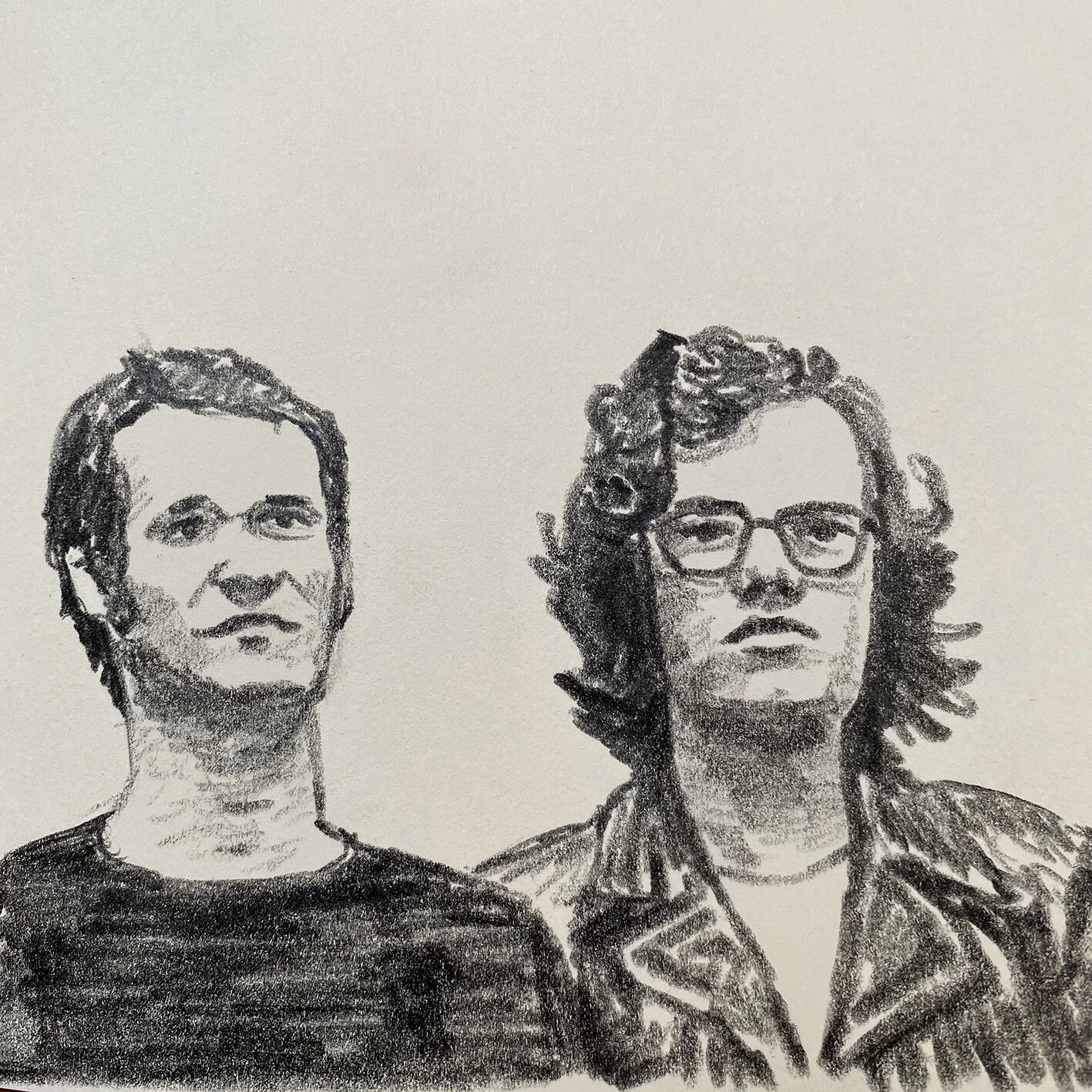Ralf MAY HAVE BEEN cooler but there was something more knowing and ironic about FLORIAN Schneider: there always seemed to be a half-smile on his face. FENNER PEARSON’S PERSONAL TAKE ON THE UNIQUE LEGEND OF KRAFTWERK.
Words and curation by Fenner Pearson, artwork by Mick Clarke, as ever!
When I was around fourteen or fifteen years old, Monday to Thursday, I'd have my dinner, do my homework and, just before eight o'clock, I'd bike the half mile up to Darren Lodge's house. There, we'd play poker for matchsticks and listen to David 'Kid' Jensen.
Sure the cool kids stayed up later and listened to John Peel but Jensen was the man for us. His easy, affable manner set him apart from the other Radio One DJs but the reason we really loved him was for the music he played. It was through him that I discovered some of my favourite bands; Simple Minds, Japan, and, of course, Kraftwerk.
'The Model', the first song I heard by the band, was originally released as a b-side in the summer of 1981, in the middle of the year that synth pop (as it's now known) established itself in charts: 'Soft Cell's 'Tainted Love'; The Human League's 'Love Action'; Depeche Mode's 'New Life'; OMD's 'Joan of Arc; and many more.
In those days, pre-Web, where one had to scratch around for any information about bands, I initially had no idea that Kraftwerk was anything other than a one hit wonder but as soon as I found out they'd released several albums, I bought them all. The sublime and consistently brilliant combination of their music and artwork took hold of me and never let go: forty years later, they remain my favourite band.
And gradually I found out more about them. The names of the members of the band, who did what, about their Düsseldorf studio. Their secretive nature was both frustrating and enticing, as were the rumours about them. Was it true that the phone in their studio had its ringer disabled and that if he had an interview or meeting scheduled, Ralf Hütter would simply pick up the phone at the appointed time? No one knew!
Last week, the news broke that Florian Schneider, one of the band's founder members, had passed away a few days before. I was always torn over who was my favourite 'werker. Ralf was definitely cooler but there was something more knowing and ironic about Schneider: there always seemed to be a half-smile on his face.
It was certainly Schneider who took the band down a more experimental route sonically. In their early days it was he that bought the electronic units to process the sound of his flute and Hütter has described him as a "sound fetishist". Apart from that, it's hard to determine who was responsible for what within the band.
What is certain is that between them they found a path for themselves as German artists that managed to culturally skip forty years from the 30s to the 70s. And with only a nod to Gilbert and George and, possibly, 'Jetsex' by Tonto's Expanding Headband, they managed to produce from thin air an aesthetic that would increasingly influence music for the next forty years and beyond.
I reckon that emotionally Schneider left Kraftwerk after 2003's ‘Tour de France', although he toured with them until 2006. He formally left a couple of years later. But for me, he will always be part of the band not least because Kraftwerk, for me, is their work from 1974 to 1986 and he is completely integral to that. So what better time to take a Spaziergang through the back catalogue of this most extraordinary band.
Ideally, we’d start with a track or two from their earlier albums: ‘Kraftwerk’, ‘Kraftwerk 2’, and ‘Ralf and Florian’. However, Kraftwerk are nothing if not the curators of their own history and those three albums – all successful in their native Germany – have been omitted from ‘Der Katalog’, the canonical self-definition of what is Kraftwerk. You can pick these albums up on bootleg easily enough but an outfit called Zeitkratzer have also produced faithful renditions of some of the tracks and you can find those on Spotify.
And so to the canon, then, and we are straight in at the deep end with the full twenty-three minutes of ‘Autobahn’, as endured repeatedly by my family on our holidays to the Lake District in the early eighties. To be honest, I could write an essay on this one song, which materialises in its contemporary cultural space without precedent. Bizarre as it might seem now, no one prior to this had taken the – with hindsight – obvious step of writing music on electronic instruments without trying to be musically unconventional. It is only its length that prevents ‘Autobahn’ being described as a pop song. (Incidentally, don’t believe the lazy copy and paste journalism that describes it as their first wholly electronic track; it features both guitar and flute.)
The second side of the album is much more in the vein of their earlier releases although ‘Kometenmelodie 2’ – their second single, released before the severely truncated version of ‘Autobahn’ – demonstrates the band’s feel for both groove and musical dynamics, which would become increasingly evident over their subsequent albums.
It would be easy to feel Kraftwerk suffered a temporary loss of direction with their follow up, ‘Radio-Activity’, but it is the band’s most coherent concept album, blending found sounds, synthesized emulations of cosmic phenomenon, and catchy pop songs. It also features ‘Uranium’, sampled by New Order for ‘Blue Monday’. For the playlist, I’ve chosen ‘Radioactivity’, a song that would mutate more than any other over the following four decades, the poppy ‘Airwaves’, and ‘Ohm Sweet Ohm’, which opens with a speech synthesiser, a tool that would become something of a passion for Schneider.
1977’s ‘Trans Europe Express’ feels like a more natural follow up to ‘Autobahn’ although it is a huge advance over the previous albums compositionally, technically, and in its performance and presentation. Kraftwerk’s members described themselves as “Europeans with German passports” and the album opens with the beautiful ‘Europe Endless’. A more song-based album, the first side also features ‘Showroom Dummies’, which presages the ‘man-machine’ concept. But it’s the second side that opens with the three part title track that would arguably be their most influential work. The sampling of this track by Afrika Bambaataa would, I’d argue, do more than anything else to secure their reputation and legacy.
‘The Man Machine’ is both short and self-confident. It features ‘The Model’ but also the haunting and much covered ‘Neon Lights’. Nothing comes close to the original, though, either sonically or in delivery. There is something far more effective in Hütter’s dry, factual vocal than any more impassioned singing. ‘The Man Machine’ is Kraftwerk’s most accessible album and three of the remaining four tracks from this release feature later in the playlist.
Writing in 2020, it’s very hard to provide the context for 1981’s ‘Computer World’, which not only sounded like the future but accurately predicted it. Kraftwerk foresaw the widespread adoption of the home computer well over a decade in advance, along with computer dating and the more sinister aspects of centralised personal data. I’ve added the entire first side to the playlist just as it perfectly appears on the album.
The second side opens with ‘Computer Love’ and it’s here that I’ll stop to mention how much I prefer the German versions of all of Kraftwerk’s album’s. Although there are musical differences and even additional lyrical content (on ‘Computer World’, for example), hearing the lyrics sung in German is so much more effective and especially so on ‘Computer Love’, where the German version has the additional sorrowful syllable of ‘Computer Liebe’.
There was an unprecedented three year gap between ‘The Man Machine’ and ‘Computer World’ and an even longer wait for ‘Electric Café’, although the excellent ‘Tour de France’ single was released during this period. I remember one of the owners of Kingston’s prosaically named The Record Shop showing me a notice in a trade magazine announcing that ‘Technopop’ would be released sometime around 1983 but it didn’t materialise. For the first time, I believe Kraftwerk were struggling with their musical direction. Often referred to in dismissive terms, the first side of the eventual album – now rechristened ‘Electric Café – actually consists of one of my most played Kraftwerk pieces, the triptych of ‘Boing Boom Tschak’, ‘Techno Pop’, and ‘Musique Non Stop’. But in terms of new material, that would be it until 1999’s ‘Expo 2000’.
In the eighties, Kraftwerk reconfigured their Kling Klang studio from analogue to digital, a process that included transferring all of their existing tapes to new media. From this arose ‘The Mix’, reworkings of many of their best known tracks, including ‘The Robots’, featuring Schneider’s patented Roboxox, and a radically overhauled ‘Radioactivity’.
Despite a brilliant world tour to promote this career retrospective, it would be easy to think that Kraftwerk petered out around this point but they returned just before the end of the decade with ‘Expo 2000’ and then, unexpectedly, with 2003’s ‘Tour de France Soundtracks’. I’d argue that in terms of songwriting, this is one of the weakest outings in the band’s catalogue but sonically it’s excellent, as demonstrated by ‘Vitamin’, ‘La Forme’ and, my favourite, ‘Elektro Kardiogramm’.
The subsequent live album ‘Minimum Maximum’ is most definitely worth a listen, including a majestic performance of ‘The Man Machine’ but it turned out that this was the start of the curation phase Kraftwerk’s history. Schneider dismissed it as “a museum” but Hütter has assiduously worked on the re-presentation of the studio albums from ‘Autobahn’ to ‘Tour de France’ as ‘The Catalogue’ as well as the subsequent live boxed set, which features all of the albums performed live in their entirety. From this, I have chosen the final (to date) incarnation of ‘Radioactivity’, ‘Antenna’, ‘Spacelab’, ‘Electric Café’, and ‘Music Non Stop’.
Whilst Hütter claims there is new material in the offing, it seems unlikely to me that he will add to The Catalogue; the work appears complete. I was lucky enough to see two of the shows at Tate Modern from the tour which resulted in the live catalogue. Subsequent to that, I have seen them from the front of an auditorium in Liverpool and the very back of the Royal Albert Hall. I decided that would be the last time I saw them but then they popped up at the Bluedot festival but now I do feel sated. I don’t need to see them live again but I can’t imagine that I will ever stop playing their music, which for me is, indeed, non stop.






